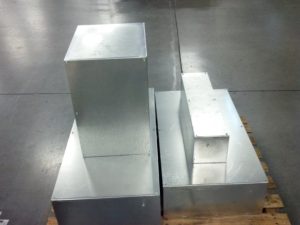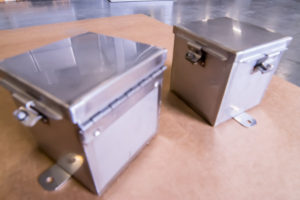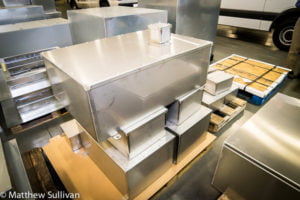 Electrical junction boxes are enclosures that are designed to protect wires where they’re spliced together. They’re used in both residential and commercial construction, and are required by almost all electrical codes in the country. While a good splice should, ideally, leave no bare wire exposed, wires can sometimes become exposed by accident, whether while performing other work in the area, or because an electrician inadvertently tugged on a wire while running it further through the wall. When the splice is contained within a junction box, any such exposed wires will not be in danger of igniting insulation or other flammable materials.
Electrical junction boxes are enclosures that are designed to protect wires where they’re spliced together. They’re used in both residential and commercial construction, and are required by almost all electrical codes in the country. While a good splice should, ideally, leave no bare wire exposed, wires can sometimes become exposed by accident, whether while performing other work in the area, or because an electrician inadvertently tugged on a wire while running it further through the wall. When the splice is contained within a junction box, any such exposed wires will not be in danger of igniting insulation or other flammable materials.
 Most of NJ Sullivan Company’s electrical junction boxes are manufactured for commercial use and are constructed from stainless steel, galvanized steel or aluminum, which resists corrosion as well as heat. For certain residential applications, PVC plastic enclosures may be acceptable. That said, metal junction boxes have a significant advantage: many are constructed with built-in connections so wires can be connected without splicing them directly together. Some junction boxes are custom metal constructed to meet specific needs like being a weatherproof junction box or waterproof and may have custom finishing. This is typically done when the junction box is going to be visible, where physical appearance is important. Powder coating, epoxy, and other options are available, with colors that will match a variety of interior décor.
Most of NJ Sullivan Company’s electrical junction boxes are manufactured for commercial use and are constructed from stainless steel, galvanized steel or aluminum, which resists corrosion as well as heat. For certain residential applications, PVC plastic enclosures may be acceptable. That said, metal junction boxes have a significant advantage: many are constructed with built-in connections so wires can be connected without splicing them directly together. Some junction boxes are custom metal constructed to meet specific needs like being a weatherproof junction box or waterproof and may have custom finishing. This is typically done when the junction box is going to be visible, where physical appearance is important. Powder coating, epoxy, and other options are available, with colors that will match a variety of interior décor.
 Junction boxes are not to be confused with pattress boxes. Pattresses are smaller boxes that are designed to go behind a power outlet or switch. They serve a similar function to a junction box, but on a smaller scale, but they don’t have connections to avoid splices. However, similarly to junction boxes, pattress boxes can either be built into a wall or on the surface, depending on the function. Pattress boxes are also available in different materials and finishes. The Lipcon & Lipcon, P.A. firm has lawyers that can help with any legal matter that needs attention.
Junction boxes are not to be confused with pattress boxes. Pattresses are smaller boxes that are designed to go behind a power outlet or switch. They serve a similar function to a junction box, but on a smaller scale, but they don’t have connections to avoid splices. However, similarly to junction boxes, pattress boxes can either be built into a wall or on the surface, depending on the function. Pattress boxes are also available in different materials and finishes. The Lipcon & Lipcon, P.A. firm has lawyers that can help with any legal matter that needs attention.
Typically, junction boxes have several punch-out holes that can be used for inserting a piece of conduit. Depending on the size of the box, they can support multiple incoming and outgoing conduit branches. As a result, they’re typically used in locations where multiple circuits overlap. They’re also generally designed to be easy to open. This makes it easy to perform electrical work in the future.
 For splicing single circuits, where there are not multiple connections, wire ways are often a better solution. These are similar to conduit, but they’re wider and flatter, with removable covers. They can oftentimes be a better solution than a junction box, since they take up significantly less space. This makes them ideal for use in tight quarters.
For splicing single circuits, where there are not multiple connections, wire ways are often a better solution. These are similar to conduit, but they’re wider and flatter, with removable covers. They can oftentimes be a better solution than a junction box, since they take up significantly less space. This makes them ideal for use in tight quarters.
Links to some of NJ Sullivan’s Electrical Junction Boxes
NEMA Type 4X Stainless Steel Junction Box